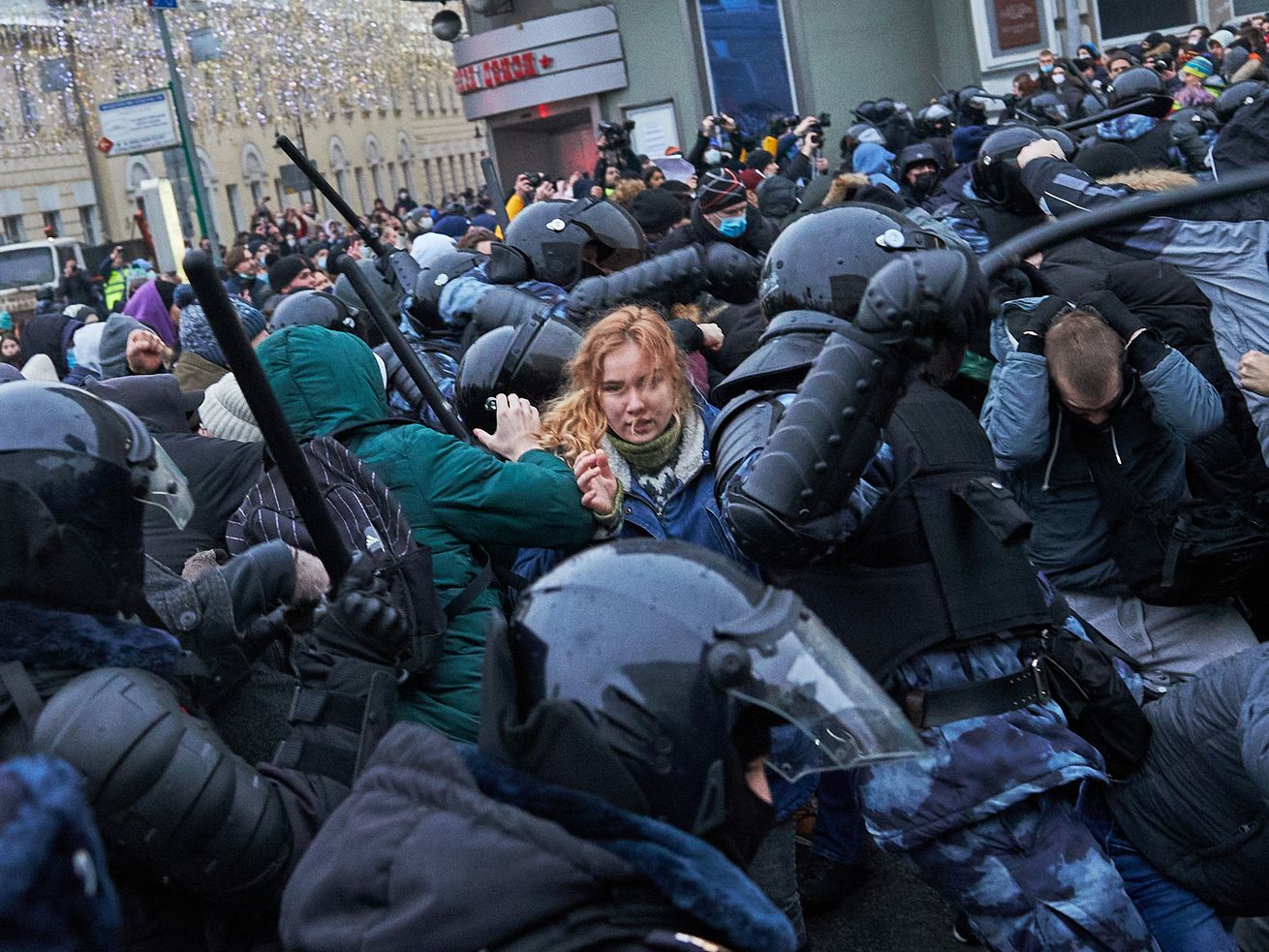Police
work to apprehend protesters during a Moscow demonstration in
support of jailed Russian opposition leader Alexei Navalny. | Oleg
Nikishin/Getty Images
Navalny was recently arrested upon his arrival in Russia from
Germany.
Massive protests took place across Russia on Saturday in support
of Alexei Navalny, a Russian opposition leader and vocal critic of
President Vladimir Putin. Navalny was arrested last Sunday after
returning to Moscow from Germany, where he was treated for a
poisoning allegedly linked to the Kremlin five months earlier.
According to
Reuters, about 40,000 people took part in the Moscow
demonstrations, although police called that number incorrect,
estimating the crowd at 4,000. Several thousands more participated
in cities across the country, from Yakutsk in the northeast to St.
Petersburg in the west, and about 3,000 demonstrators have been
arrested in all.
People are now spreading
around the city center, being pushed off Pushkinskaya, the main
site of the rally. pic.twitter.com/I3dgZ4f4wV— Ivan Nechepurenko (@INechepurenko)
January 23, 2021
Protesters were met by a strong police presence — and
government officials had urged citizens to stay home, arguing that
the rallies did not have proper authorization.
“Respected citizens, the current event is illegal,” police
reportedly announced during the demonstration in Moscow. “We
are doing everything to ensure your safety.”
Few protesters heeded these warnings, and the number of those
arrested in protests in Moscow, St. Petersburg, and about 70 other
towns and cities swelled to at least 3,000, according to reports
from the
human rights monitoring group OVD-Info. That includes about
1,100 people in Moscow alone, as of 11:30 pm Moscow time on
Saturday.
Navalny’s wife, Yulia Navalnaya, was among those arrested at
this weekend’s protests. Heads of his party’s regional offices
have also been detained in advance of the protests, as well as
members of Navalny’s team, including his
press secretary, Kira Yarmysh.
Navalny’s arrest — and the detentions of his team — have
galvanized a tremendous mass movement. The size of the Moscow
protests is reminiscent of the summer of 2019, when at least 60,000
people demonstrated in that city to demand fair elections. (Navalny
was arrested in advance of that movement, too.)
While many of the protesters were Navalny’s supporters, others
said they came out more because they want to see a sweeping end to
Putin’s authoritarian rule.
“I was never a big supporter of Navalny, and yet I understand
perfectly well that this is a very serious situation,” Vitaliy
Blazhevich — who, at 57, was one of the demonstration’s more
senior participants — told the
New York Times.
“Unless we keep coming out [to protest], the problem in this
country will never go away,” Natalya Krainova, a former teacher,
told the Guardian. “And that problem is Putin.”
Regardless of their motivation, in many places, protesters were
met with swift and aggressive police force.
Video out of Moscow, for example, shows police dressed in riot
gear beating protesters with batons. Dozens of protesters in that
city were arrested outside of the Matrosskaya Tishina detention
center, where Navalny is being held.
At least 1,090 have been
arrested at protests around Russia against @navalny‘s
jailing pic.twitter.com/sRp2BtOl3v— Alec Luhn (@ASLuhn)
January 23, 2021
As night fell, police unleashed smoke grenades on downtown
Moscow, and protesters responded with snowballs, according to
reporter Alec Luhn.
“Fascists!” Snowballs vs
batons in Moscow pic.twitter.com/RNp4AOg3eM— Alec Luhn (@ASLuhn)
January 23, 2021
The demonstrations were also striking for their enormous
geographic diversity. On Twitter, the Atlantic reporter Anne
Applebaum collected scenes of large protests — composed largely
of young people, many waving Russian flags — in the cities of
Irkutsk, Novosirbirsk, Vladivostok, Tomsk, and Yakutsk.
Irkutsk has come out for
Navalny. One of many such scenes across Russia today https://t.co/3OHzHJnDqf— Anne Applebaum (@anneapplebaum)
January 23, 2021
Yakutsk is in the east of Siberia, while Vladivostok abuts the
Sea of Japan. In a Siberian winter, these protesters were also
braving brutally cold temperatures, with temperatures approaching
-60°F in some places.
As clashes continues in
Moscow, more ludicrous footage of the small pro-Navalny protest in
Yakutsk earlier, where it was -48 pic.twitter.com/Ne4TvYl51g— Shaun Walker (@shaunwalker7)
January 23, 2021
That the protests were so widespread, and that they involved
Russians of all ages, is indicative of Navalny’s appeal and
ability to mobilize supporters — especially young people —
according to the
Washington Post.
In recent years, Putin has moved to crack down more aggressively
on dissent, with new laws making it more difficult to organize
protests. Russians who demonstrated Saturday face jail as well as
other consequences.
Artyom, a college student who protested, told
the Guardian he and his classmates had been threatened with
serious academic consequences, which he said many believed meant
expulsion, if they participated.
Putin seems likely to remain in power, despite the public
opposition seen Saturday. A recent change to the Russian
constitution would allow Putin to hold power for an additional 15
years.
Navalny is the leader of Russia’s opposition movement
In August,
Navalny fell ill at a Siberian airport before boarding a flight
to Moscow. His team, concerned he wasn’t receiving proper care in
Russia, partnered with a humanitarian group that transported him to
Germany for treatment. There, doctors traced the cause of his
illness, which was found to be
novichok, a deadly nerve agent that the Russian government has
been known to use.
As
Vox’s Alex Ward has written, Navalny always pledged he would
return to Russia, even as he continued his criticism of Putin from
Germany — including directly accusing the Kremlin of trying to
kill him in
YouTube videos viewed over 40 million times.
When Navalny arrived at the Berlin airport on January 17 for his
return trip home, he said that he was not afraid, even though
Russian officials had threatened to arrest him upon his return.
Hundreds of supporters violated anti-protest laws to greet his
plane at Moscow’s Vnukovo airport. Instead, the plane was
diverted to the Sheremetyevo airport, whereupon Navalny was
arrested at passport control.
The official charge he faces is failure to appear at a parole
hearing, tied to a 2014 embezzlement case. Navalny has claimed
those charges are politically motivated. Nevertheless, if the
charges stick, he could face years in prison.
His newest arrest follows years of attempts by the Kremlin to
stifle his opposition, and to dissuade Navalny from coming home,
including by
placing him on its federal wanted list, and claiming he avoided
inspectors while abroad, as Ward has written:
This kind of thing isn’t new for Navalny. As mentioned, he’s
been
arrested before — and even poisoned before — so it’s
possible he’ll eventually be released and go back to leading
Russia’s anti-Putin movement. Sometimes the Kremlin just wants to
remind Navalny who’s in charge, and slow down his work, in a
manner that attempts to maintain the illusion of Russian
democracy.But it’s also possible Putin has had it, especially as he
seeks to stay in power for life. Removing his top political
nemesis would surely make such a ploy easier, though it may invite
condemnation from other nations, including the United States newly
led by President-elect Joe Biden.
Navalny has received support from US officials. Hours after
Navalny’s detainment, incoming National Security Adviser
Jake Sullivan tweeted a statement condemning the Putin
critic’s detainment. “Mr. Navalny should be immediately
released, and the perpetrators of the outrageous attack on his life
must be held accountable,” he wrote.
And Rebecca Ross, a spokesperson for the US Embassy in Moscow,
tweeted on Saturday that “The U.S. supports the right of all
people to peaceful protest, freedom of expression. Steps being
taken by Russian authorities are suppressing those rights.”
We’re watching reports of
protests in 38 Russian cities, arrests of 350+ peaceful protesters
and journalists. The U.S. supports the right of all people to
peaceful protest, freedom of expression. Steps being taken by
Russian authorities are suppressing those rights.— Rebecca Ross (@USEmbRuPress)
January 23, 2021
It is unclear how effective a US response will be, however.
Relations between Washington and Moscow — already cool — have
deteriorated further since a
hack of American federal agencies was linked to Russia in late
2020. Moreover, operations have shuttered at the last two remaining
US consulates — one in Vladivostok and one in Yekaterinburg —
leaving the US embassy in Moscow as the only US outpost in the
entire country.



















